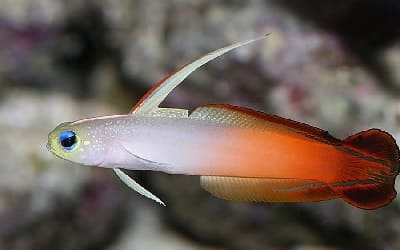Home › Sea Life › Marine › Vertebrates › Gobies › Red Fire Goby
Information about Red Fire Gobies
[Phylum: Chordata] [Class: Actinopterygii] [Order: Gobiiformes] [Family: Gobiidae]
The distinctive body colour and a non aggressive nature are the main reasons why aquarists keep firefish gobies as pets. But, divers can also find them thriving in their natural habitat.
This section contains interesting facts and information about the fire goby fish, including where to find them, what they eat, and how they reproduce.
Red Fire Goby Fish Habitat and Distribution
Its scientific name is Nemateleotris magnifica, but it has several other common names, including:
- Firefish goby
- Fire goby
- Magnificent firefish
- Fire dartfish
In the wild, they live around the coral reefs in large areas of the Indian and Pacific oceans - even as far north as the Ryukyu Islands (Japan).
For the most part, gobies inhabit shallow outcrops at depths around six to ten metres. Even so, it's not uncommon to find them in much deeper water - down as far as seventy (70) metres (230 feet).
The firefish goby is an elongated, slender bodied, bottom-dwelling 'omnivorous' fish. It spends most of its life close to the ocean floor and facing into the current to catch its favourite food, including tiny invertebrates.
Pro Tip: The main section has more goby fish facts and a short video showing how the pistol shrimp and goby fish join forces to dig a safe burrow in the sediment.
Behaviour and Characteristics
The firefish goby has several prominent features. The colour of the head is usually a bright yellow, which starts to merge into a long slender body that contains a lot of white.
The white colouring changes to a red-orange hue as it gets closer to the dark red tail. They have extra long dorsal fins, which they tend to flick back and forth in some kind signaling action. Scientists think it alerts others about an impending danger or it's used as a defence mechanism.
 For the most part, adult firefish gobies grow to a maximum length of around nine (9) centimetres (3.5 inches).
For the most part, adult firefish gobies grow to a maximum length of around nine (9) centimetres (3.5 inches).
But, some of the subspecies have different body colour and reach different lengths as they mature, such as:
- Helfrich's dartfish (Nemateleotris helfrichi)
- The purple firefish (Nemateleotris decora) - sometimes called the elegant firefish.
Juvenile firefish gobies tend to live in small groups. But, the monogamous adults like to stay together in pairs.
In general, these small creatures are timid and live a somewhat 'shy' lifestyle. They will dart into the sanctuary of a sand burrow hiding place any time they feel the slightest hint of a threat from a predator.
What Do Firefish Gobies Eat?
The main source of food for red fire gobies will include planktonic organisms, such as algae, zooplankton, and sea worms.
Here's the thing:
If you're keeping Nemateleotris magnifica species in an aquarium, they will feed on mysid crustaceans, including brine shrimp and mysis shrimp.
Pro Tip: Almost all gobies fishes are active and they may even use aggression to establish dominance when kept in captivity. As a result, they might jump out of the fish tank if the lid is open.
Red Fire Goby Reproduction
Male and females typically share the burrow which provides them with a sheltered place to spawn. The genders dig with their mouths and keep the burrow clear of debris by fanning away sedimentary sand.
Goby females often lay up to 5,000 eggs during the reproductive period. The eggs stick to vegetation such as coral and substrate. The male supervises the eggs for a few days until they hatch as new colourless larvae.
Most of the young will only take a few months to reach adult maturity. In general, warm water dwellers can live for a period of up to ten (10) years.
Natural Predators and Threats
Gobies have few predators because of their unique burrowing behaviour. Even so, some of the larger predatory fish species and wading birds will eat gobies if they are quick enough.
According to the International Union for Conservation of Nature (IUCN), the current conservation status of the red goby fish is 'Least Concern' (LC).
Related Information and Help Guides
- Blenny Fish Facts and Species Information
- Flashlight Fish Fun Facts and Information
- Marine Vertebrates with Examples and Pictures
- Pygmy Goby Facts and Information with Pictures
- Yellow Watchman Goby Fun Facts and Information
- Wrasse Fish Species Interesting Information
Note: The short video [4:13 seconds] presented by 'Eagle Aquatics' explains more about how to keep the firefish goby in captivity as a pet.